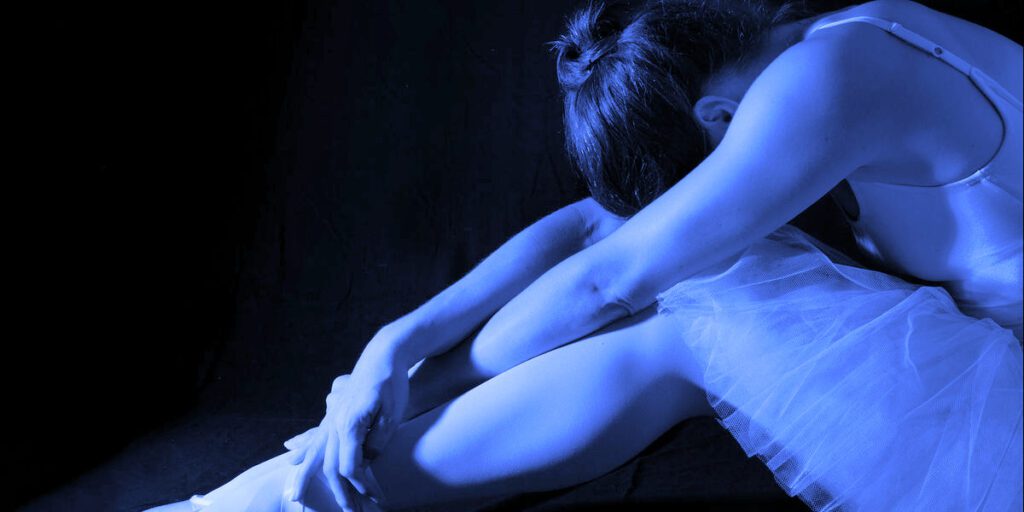 Grieving and dancing share a similar status in popular mass culture. They are both to be avoided so as to maintain one’s dignity and composure. The song, “I won’t dance, don’t ask me” expressed a theme that was prominent for my first husband, and common for white men of his generation. “Besides, you do quite well dancing on your own,” he’d tell me. Men might get away with jumping around to the music at a wedding reception but only after people’s inhibitions had been loosened by alcoholic beverages. Women’s inhibitions regarding dancing might include feeling too clumsy or fat or believing what they’d been told, that “I don’t have rhythm,” or as the expression goes, “I have two left feet.” But being human, we are built for dancing and for grieving. Both grieving and dancing require being in one’s body and being able to express a full range of emotions, especially those deemed off limits in polite society.
Grieving and dancing share a similar status in popular mass culture. They are both to be avoided so as to maintain one’s dignity and composure. The song, “I won’t dance, don’t ask me” expressed a theme that was prominent for my first husband, and common for white men of his generation. “Besides, you do quite well dancing on your own,” he’d tell me. Men might get away with jumping around to the music at a wedding reception but only after people’s inhibitions had been loosened by alcoholic beverages. Women’s inhibitions regarding dancing might include feeling too clumsy or fat or believing what they’d been told, that “I don’t have rhythm,” or as the expression goes, “I have two left feet.” But being human, we are built for dancing and for grieving. Both grieving and dancing require being in one’s body and being able to express a full range of emotions, especially those deemed off limits in polite society.
I began dancing at 3 years old, before I knew the rules, living out my mother’s lifelong desire for dancing lessons instead of the piano lessons her mother insisted on requiring of her. In her day dancing was an activity banned by Christians in the Bible Belt, grouped together with notorious activities such as drinking, cussing, gambling, and card playing. In other words, not an activity for respectful gentile ladies. Dancing captured me and has been a central activity of my life. I’ve kept dancing, way longer than most people, and longer than I had expected to be able to do. When I was a professional dancer, I experienced something common to highly trained athletes, an awareness I now know to be the ever-present anticipatory grief that this next season, this next injury, this next birthday, could bring with it the finale of my ability to continue doing what I love. The gift of this awareness that life as I know it will end, has enhanced its value to me, and increased my gratitude for being able to dance, now into my eighties.
Dancers know that words alone cannot communicate profound truths. We must have an embodied experience to understand loss and recommit to life again. An example of this occurred when I danced at my best friend Rose’s funeral. I had been with her for the 14 days it took for her to die, and during this time, she planned her funeral. I’d never heard of anyone dancing at a funeral, but when she asked me, I agreed to do it. What I remember about the experience was incorporating into the dance some light feathery tree limbs that gardeners had left on the hospice walkway. My motions were sweeping, as though clearing, and cleaning the ground. After the service a friend of Rose’s, a Native American woman came up to me, her eyes sparkling. In an energetic and determined voice she said, “Thank you so much for your dance. I have been in a state of confusion and uncertainty about what to do next in my life. Seeing your dance, I’m clear. I now know what it is I need to do” and she left the gathering. The soap opera details were missing but I understood what she meant.
Grief is the process of metabolizing our experiences of loss so that the wisdom in those experiences becomes available in our future lives. We cannot process what we cannot remember, and we cannot remember what we were not fully present for. In western culture, we often think of our bodies as just the way our heads and logical brains get transported from one place to another. For dancers, the body is the vehicle to experience and express the energy that is moving through it. It is the way experience is recorded and recalled. When dancers dance, through the magic of “mirror neurons,” in the bodies of those who witness the dance–the dancer’s dance moves them too.

